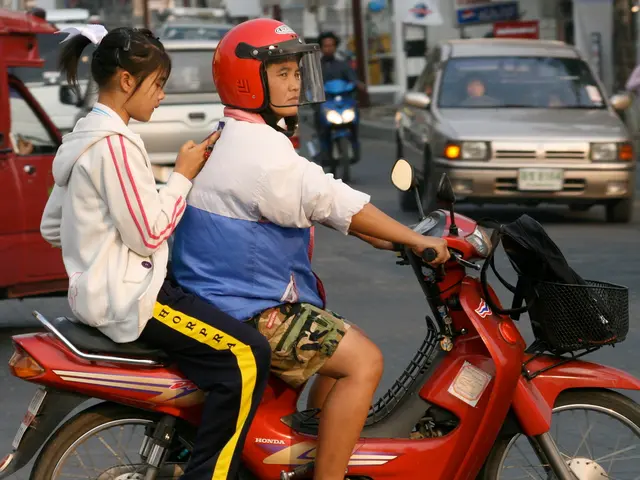Autonomous Tesla Vehicles Transition from Factory to Showroom (VIDEOS)
In the heart of Texas, Tesla's Giga Texas factory is making significant strides in both self-driving vehicle technology and sustainable development.
Tesla's self-driving ambitions are taking shape with the launch of its commercial Robotaxi service in Austin, Texas, on June 22, 2025. This marks a significant milestone in Tesla's Full Self-Driving (FSD) capabilities being used for passenger transport in a real-world setting[3]. The company is expanding the geographic coverage of the Robotaxi operation from about 42 square miles to potentially 450 square miles, a tenfold increase. This expanded geofence includes rural and suburban areas around Austin, demonstrating Tesla's efforts to validate FSD beyond simple urban environments[2].
Tesla's 2025 FSD roadmap anticipates launching an "FSD Unsupervised" mode in select US cities by the end of 2025. This mode allows the vehicle to operate without active driver supervision, highlighting progress toward fully autonomous driving[1]. The Giga Texas factory, located near Austin, is pivotal in producing vehicles equipped with advanced FSD hardware such as the Hardware 4 (HW4) and AI4 computer chips. The latest over-the-air software updates (2025.26.4) rolling out to these vehicles enhance AI functions, including Tesla’s Grok AI chatbot integration and other improvements supporting autonomous capabilities[4].
Tesla's approach to self-driving relies on neural networks trained with data from millions of Tesla drivers, focusing on camera-based perception without lidar, differentiating Tesla's system from competitors relying on extensive 3D mapping and lidar[3]. However, a recent strategic shift in AI hardware development may impact future autonomous vehicle capabilities developed at Giga Texas, as Tesla has disbanded the Dojo supercomputer project to focus on new AI chip generations (AI5 and AI6)[5].
Away from the self-driving vehicles, Tesla is making strides in sustainable development. The company has revealed detailed plans for a massive ecological riverfront project at the Giga Texas site. The centrepiece of this project is the Giga Texas Riverfront Echo Park, which will span along the Colorado River. The park will include a sports complex near the southeast horse ranch area, a network of trails, boardwalks, and green spaces, as well as a restored riverfront and wetlands[6].
Outdoor workspaces, a community circle, and open-air gathering areas are part of the Giga Texas Riverfront Echo Park. Access points for kayaking or river use are also included. Some ecological restoration efforts along the river at the Giga Texas site have already been completed[6]. The park's design is intended to provide a habitat for local wildlife and promote biodiversity. The Giga Texas Riverfront Echo Park includes an ecological preserve with walking and biking trails.
Tesla is also making use of its FSD technology internally, with driverless vehicle transfers at the Giga Texas factory. New Model Y and Cybertruck vehicles are moved across the campus autonomously, navigating roads and intersections without human input. A human operator takes over for final positioning of the vehicles once they arrive at the outbound lot[7].
These developments at Giga Texas showcase Tesla's commitment to pushing the boundaries of self-driving technology while maintaining a focus on sustainability and environmental responsibility. For more insights into these developments, check out Joe Tegtmeyer's YouTube channel for a video update featuring the self-driving vehicles at Giga Texas and the planned park area[8]. Another drone pilot, Brad Sloan, has also released a video showcasing self-driving Teslas at Giga Texas[9]. The FSD technology is designed to reduce time and labor, cutting the need for shuttle trips and potentially improving overall production efficiency[10].
- Tesla's Giga Texas factory, situated in Texas, is not only advancing self-driving vehicle technology, but also focusing on sustainable development through a massive riverfront project, the Giga Texas Riverfront Echo Park.
- The Giga Texas Riverfront Echo Park, a significant part of Tesla's ecological riverfront project, includes a sports complex, various trails, green spaces, and restored riverfront and wetlands, promoting local wildlife and biodiversity.
- Apart from this, Tesla is utilizing its self-driving technology inside the Giga Texas factory, where new Model Y and Cybertruck vehicles are moved around autonomously, navigating roads and intersections without human input.
- Tesla's expansion of the geographic coverage of its Robotaxi operation, initially confined to urban areas, to potentially 450 square miles, demonstrates their ambition to validate their Full Self-Driving (FSD) capabilities beyond simple urban environments, which may have implications for the transportation industry as a whole.
![Autonomous Tesla Cars Navigate Directly from Manufacturing Site to Sales Area [VIDEO FOOTAGE]](/en/content/images/size/w1280/format/webp/20250816222617_tesla-self-driving-vehicles-on.jpeg)






